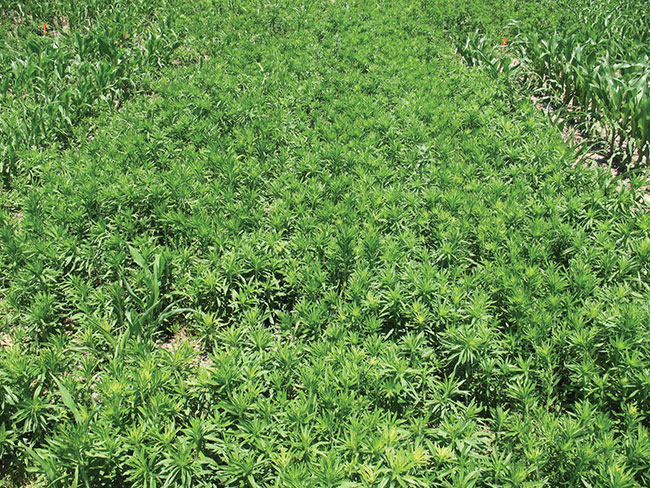
Features
Editorial: Using tools responsibly
December 12, 2023 By Alex Barnard
 Photo courtesy of Peter Sikkema, University of
Guelph, Ridgetown Campus.
Photo courtesy of Peter Sikkema, University of
Guelph, Ridgetown Campus. You’ve probably heard the saying, “With great power comes great responsibility.” While none of you have likely been bit by a radioactive spider and developed superpowers to fight crime in New York City, farmers do have access to a highly specialized arsenal of tools to combat the plethora of pests and diseases each season.
But how long will those tools remain effective?
At this summer’s Ontario Crop Diagnostic Days at the University of Guelph’s Ridgetown Campus, OMAFRA’s Tracey Baute, and the university’s Jocelyn Smith and Yasmine Farhan presented on European corn borer and how it has overcome some of the Bt corn traits that have effectively controlled for more than twenty years.
In our November/December issue, Carolyn King writes about how most growers are using soybean varieties with resistance genes that were no longer effective against the Phytophthora root rot pathogen. These announcements are concerning, as these tools are the result of a lot of research, time and effort, and in many cases, there are no similar tools in the pipeline.
And with the incursion of weeds like waterhemp and Palmer amaranth, keeping as many chemical control options available for as long as possible, especially when these weeds are so adept at developing resistance, will be clutch.
Part of the issue is that pests and diseases are very, very good at overcoming and adapting to resistance – or developing it themselves. Their survival depends on it.
Part of the issue is time and money. There are so many factors to balance in a season, and with rising costs sometimes an additional practice or product for an issue that might be a problem this season gets put on the backburner in favour of an issue that will almost definitely be a problem. There are only so many hours in a day, and only so many passes you can make through a field before you risk other issues, like compaction.
But the fact remains that these tools will only remain available – and viable as control options – if they’re used effectively and responsibly. Crop rotation, growing different hybrids or trait combinations, using different modes of action in subsequent years or using products with multiple modes of action in the same year, growing certain cover crops, knowing which pests or diseases are present or likely to afflict your fields and planning accordingly, properly calibrating sprayers – these are some of the ways to improve your chances of controlling pests and diseases that also reduce the risk of them adapting to the pesticides or used.
Integrated pest management may reduce reliance on chemical pesticides, but in most cases IPM strategies still count on having some form of chemical control available to work in conjunction with the other tools in the toolbox.
The principles of 4R nutrient stewardship – right source @ right rate, right time, right place – can, in general, be applied to pest management, as well. When choosing chemical pesticides or seed, use the:
- Right source: a different variety or crop or mode of action from the previous growing season;
- Right rate: Use a high enough concentration of pesticide to provide appropriate coverage for control;
- Right time: Apply chemical pesticides when they will be most effective (both by crop stage and time of day); and
- Right place: Make sure the pesticide is getting where it needs to go, whether that’s on the soil, in the soil, or to the plant itself.
This winter, perhaps consider if there are ways you can more better manage pest and disease pressure on your farm. You may be as responsible as you can reasonably be, or you may find a couple additional strategies to enact. Perhaps the best way you can contribute to responsible resistance stewardship is to talk to other farmers at the local coffee shop and talk about the strategies you employ – you might just inspire someone else to do a little better, too.